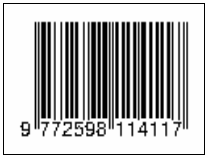Effect of Tapping System Change on the Latex Physiological Parameters in Commercial Rubber Plantations
Abstract
Latex diagnosis was introduced to monitor plant physiological status. In this study, we observed the effect of tapping system alteration in 2019 and 2020 on the latex physiological status. Latex samples were collected from 26 blocks of 10 rubber estates in North Sumatra Province, Indonesia. The physiological parameters assessed were totally solid, sucrose, inorganic phosphorus, and thiol contents. Our observation showed that the tapping system change did not significantly affect the total solid content. In terms of sucrose content, a significant effect was detected only in tapping change from quarter spiral upward tapping d3 to d4 (7.80 mM and 2.30 mM, respectively). While, inorganic phosphorus content decreased in all tapping system alterations, suggesting a metabolic response to tapping system adjustment. According to sucrose and inorganic phosphorus contents, yield optimization could be implemented in appropriate blocks. The thiols content was not significantly affected by tapping system alteration. The RSH values ranged from 0.32 mM to 0.76 mM, suggesting a wide variation in the antioxidant level of the plant. While sucrose and thiols content showed some discrepancies to the LD theory, Pi content exhibited a dependable response, suggesting that this parameter could be a good indicator to evaluate the tapping system regime. Our result could be a beneficial input for rubber planters to maintain the physiological level to the commercial extent.
References
Adou, B. Y. C., Okoma, K. M., Obouayeba, A. P., Atsin, G. J. O., Ballo, E. K., Essehi, J. L., Wahounou, P. J., Soumahin, E. F., Kouakou Tanoh, H., & Obouayeba, S. (2018). Latex micro diagnosis, modern management tool of rubber plantations of clones with active or rapid metabolism IRCA 18, IRCA 130, PB 235, PB 260 and PB 330. European Scientific Journal, 14(3), 384–407. https://doi.org/10.19044/esj.2018.v14n3p385
ASTM International. (2002). Standard Specification for Rubber — Concentrated, Ammonia Preserved, Creamed, and Centrifuged Natural Latex (D1076-02 ed., Vol. 09). ASTM International.
Atsin, G. J. O., Soumahin, E. F., Mahyao, A., Okoma, K. M., Kouakou, T. H., & Obouayeba, S. (2017). Incidence of latex harvesting technologies on agronomic and physiological parameters and profitability of some rapid metabolic class clones of rubber tree (Hevea brasiliensis) in southwestern Côte d'Ivoire. International Journal of Biological and Chemical Sciences, 11(5), 2209. https://doi.org/10.4314/ijbcs.v11i5.21
Bottier, C. (2020). Biochemical composition of Hevea brasiliensis latex: A focus on the protein, lipid, carbohydrate and mineral contents. In R. Nawrot (Ed.), Latex, Laticifers and Their Molecular Components: From Functions to Possible Applications (Issue 93, pp. 201–237). Academic Press. https://doi.org/10.1016/bs.abr.2019.11.003
Dische, Z. M. (1962). Carbohydrate chemistry. In R. L. Whistler & M. L. Wolfrom (Eds.), Methods in Carbohydrate Chemistry (Vol. 1, pp. 475–514). Academic Press.
Gohet, E., Cauchy, T., Soumahoro, M., Kotochi, C., Chegbene, P., Njoku, A., & Lesturgez, G. (2019). Meta-analysis of a large industrial latex diagnosis database provides insight on Hevea brasiliensis clonal adaptation and site-specific yield potential in Western Africa. International Rubber Conference, Nay Pyi Taw 30 September - 01 October 2019, 19 p.
Jacob, J.-L., Lacrotte, R., Serres, E., & Roussel, D. (1987). Les paramètres physiologiques du d’Hevea brasiliensis. Le diagnostic latex; ses bases; sa mise au point. IRCA Document Interne, 41.
Jacob, J.-L., Prévôt, J.-C., Lacrotte, R., & Eschbach, J.-M. (1995). Latex diagnosis. Plantations, Recherche, Developpement, 2(2), 33–37.
Jacob, J.-L., Prévôt, J.-C., Roussel, D., Lacrotte, R., Serres, E., D’Auzac, J., Eschbach, J.-M., Omont, H., Cirad-Irca, F. R. A., & Ustl, F. R. A. (1989). Yield limiting factors, latex physiological parameters, latex diagnosis, and clonal typology. In J. J.-L. C. H. D'Auzac Jean (Ed.), Physiology of rubber tree latex: the laticiferous cell and latex, a model of cytoplasm (pp. 345–382). CRC Press.
Junaidi, Wijaya, A., Rachmawan, A., & Andriyanto, M. (2019). Total solid content and compound properties from different collection time of Hevea brasiliensis latex. Acta Technologica Agriculturae, 22(4), 104–108. https://doi.org/10.2478/ata-2019-0019
Kudaligama, K. V. V. S., Lakshman, R. G. N., & Rodrigo, V. H. L. (2017). Performance of once in three days (S/2 d3) and four days (S/2 d4) tapping systems in marginal drier areas in Sri Lanka. International Rubber Conference 2017, 401–412.
Mc Mullen, A. I. (1960). Thiols of low molecular weight in Hevea brasiliensis latex. Biochimica et Biophysica Acta, 41, 152–154.
Qiu, J., Xiao, X. Z., Gao, H. H., Yang, W. F., Wei, F., Wu, M., & Luo, S. Q. (2020). Effect of tapping per six days system on the yield, latex physiology and tapping panel dryness of young Hevea brasiliensis var. Reyan 7-33-97. Journal of Southern Agriculture, 51(1), 133–139.
Rouhier, N., Cerveau, D., Couturier, J., Reichheld, J.-P., & Rey, P. (2015). Involvement of thiol-based mechanisms in plant development. Biochimica et Biophysica Acta (BBA) - General Subjects, 1850(8), 1479–1496. https://doi.org/10.1016/j.bbagen.2015.01.023
Syafaah, A., Ismawanto, S., & Herlinawati, E. (2015). Keragaman sifat pertumbuhan, fisiologi, dan daya hasil progeni karet (Hevea brasiliensis Muell. Arg.) hasil persilangan antara klon PB 260 dan RRIC 100. Jurnal Penelitian Karet, 33(2), 121–130. https://doi.org/10.22302/jpk.v33i2.177
Taussky, H. H., & Shorr, E. (1953). A micro colorimetric methods for the determination of inorganic phosphorus. Jurnal Biochemycal, 202, 675–685.
Vijayakumar, K. R., Gohet, E., Thomas, K. U., Xiaodi, W., Sumarmadji, Rodrigo, L., Thanh, D. K., Sopchoke, P., Karunaichamy, K., & Said, M. A. M. (2009). Special communication: Revised international notation for latex harvest technology. Journal of Rubber Research, 12(2), 103–115.
Zaw, Z. N., Sdoodee, S., & Lacote, R. (2017). Performances of low frequency rubber tapping system with rainguard in high rainfall area in Myanmar. Australian Journal of Crop Science, 11(11), 1451–1456. https://doi.org/10.21475/ajcs.17.11.11.pne593
Zhang, Y., Leclercq, J., & Montoro, P. (2016). Reactive oxygen species in Hevea brasiliensis latex and relevance to tapping panel dryness. Tree Physiology, 37, 261–269. https://doi.org/10.1093/treephys/tpw106
Refbacks
- There are currently no refbacks.








